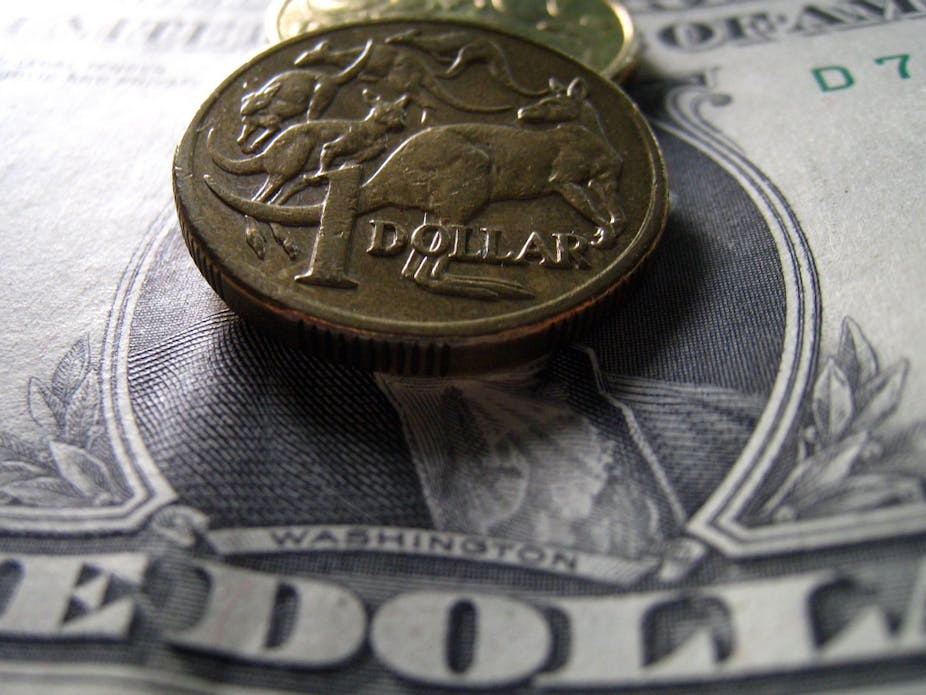As foreign central banks continue to park their money in our triple-A rated bonds, the Australian dollar continues its inevitable ascent.
The dollar traded as high as US106.03¢ after the RBA left the interest rate on hold. But economic commentators seemed more riveted with the Reserve Bank’s subtle commentary on the exchange rate in its statement released after its board meeting, widely interpreted as suggesting the RBA was concerned about its trading highs.
Former member of the Reserve Bank, Warwick McKibbin, had earlier sparked debate when he suggested that the RBA should intervene in currency markets to limit the strength of the dollar.
We asked three economists about their thoughts on whether a currency intervention would be the right course of action for the RBA.
Richard Heaney, Winthrop Professor at the University of Western Australia: On the 8 December 1983, it was decided that the Australian currency would float. The float began on 12 December 1983 with the RBA 4PM USD quote set at one Australian dollar being set equal to 0.9175 US dollars.
The exchange rate drifted downwards following the float. On 12 December 1984, the AUD was worth 0.8478 US cents and on 12 December 1985, it was 0.6840. There were some oscillations over the next 20 years or so, with the currency generally below parity. More recently, the rates have been 0.9136 on 10 December 2009, 0.9853 on the 10 December 2010, 1.0166 on the 12 December 2011 and 1.017 on the 12 July 2012.
The Australian dollar was floated in 1983 because the managed float that was in place at the time was not working. It is extremely difficult to manage a foreign currency exchange rate in a simple economy without attempting this feat in a complex modern economy that is experiencing a mining sector boom.
While it might appear to make sense for the government to step in to manage the currency when it is believed to be too high, the only individuals who will win from a return to managed floats, or fixed exchange rates, will be the new generation of George Soros-like speculators with the resources and the attitude to take on a market of this size and profit when rates move too far from their fundamental value.
Trading conditions are extremely difficult for the Australian economy at present, but it is not clear that forcing the currency down in order to make Australian “export” industries more competitive is the answer, no more than it is sensible for a government to prop up a currency to make imports cheaper. We have spent almost 30 years attempting to remove the government controls that were throttling our society and businesses. Now, there are calls for the re-introduction of the one of the worst of these controls.
The government can work to ensure we have a well educated population supported by high quality infrastructure, but it is not clear that the government should not be expected to manage the exchange rate for the benefit of Australian industry. The costs to ordinary Australians of such action might be higher than initially thought.
Graeme Wells, Associate Professor, School of Economics and Finance, University of Tasmania: Instead of investing in say, Italian bonds or French bonds, other central banks are now diversifying by investing in Australian government bonds, which are triple A. That sounds sensible. The practical implications of what Warwick McKibbin is saying that the RBA should buy those bonds that the other central banks don’t want and, in the process, depreciate the Australian dollar.
That means the Australian Reserve Bank would have a riskier balance sheet than it did before, and the money base increases as the foreign central banks buy Australian government bonds. I don’t think it’s a very smart idea; I think it might be better to cut the national interest rate and make Australian assets less attractive. In that case the Reserve Bank would hold safe Australian government bonds on its balance sheet and the money base increases in the same way as under the McKibbin proposal.
On the subject of a “fair value” of the Australian dollar, the RBA would have various models that determine the equilibrium value of Australian exchange rate. That involves relative rates of inflation, our terms of trade, relative interest rates and the price of equities - that approach generates estimates of what the equilibrium exchange rate should be, subject to lower and upper confidence intervals.
Those confidence intervals, however, are pretty wide. I think the Reserve Bank would have a model that generates a fair value over a long sample period in the past. Whether that sort of estimate of “fair value” is very useful given the post-crisis developments is an open question.
***Shaun Vahey: Professor, ANU College of Business and Economics at the Australian National University:* It doesn’t make sense to consider the nominal exchange rates as an additional monetary instrument for Australia. The priority for monetary policy should be to set the path of interest rates appropriately, taking into consideration many features of the macroeconomy, including the exchange rates. A more helpful modification would be to provide a probabilistic projection for the future cash rate, taking into account uncertainty.
The Norwegian experience suggests that this route is simple to implement and works well in a resource-rich small open economy. Reforming the process by which the RBA Board is selected would help modernise the communication and implementation of monetary policy strategy in Australia.

